Yellow Mushrooms in Houseplants: Causes and Solutions (with Pictures)
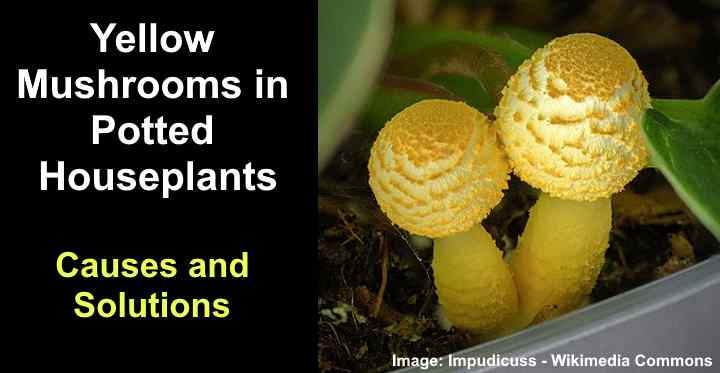
Yellow mushrooms in your houseplants, garden, or yard often signal overly damp soil. Yellow mushrooms can seemingly appear overnight in houseplants and gardens. They typically feature brightly colored, rounded, umbrella-like caps and yellow stems, growing in clusters within damp potting soil.
This article explores the various causes of yellow mushrooms growing in potted plants. You will also find tips on how to identify the yellow mushrooms and how to remove them from your indoor plants.
What Are Yellow Mushrooms in Houseplants?
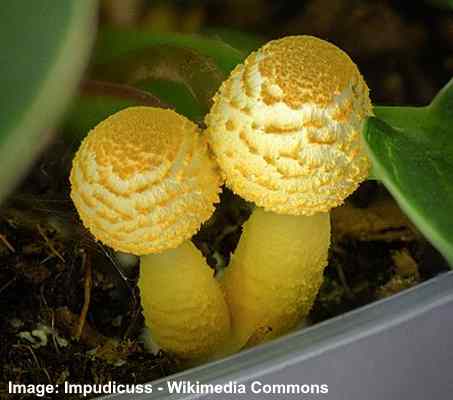
Yellow Leucocoprinus birnbaumii mushrooms growing in a houseplant pot
Yellow mushrooms that grow in houseplants are typically a fungus known by the botanical name Leucocoprinus birnbaumii. These mushrooms are also referred to as yellow parasols, plantpot dapperlings, yellow houseplant mushrooms, or flower pot parasols. They can be found growing in houseplant soil throughout the year. However, outdoors, they tend to grow from summer through fall.
The yellow mushrooms in potted plants may initially appear as pale yellow bumps on the soil surface. Soon after, round to conical caps emerge atop cylindrical yellow stems (stipes). These bright yellow mushrooms tend to grow in clusters.
Yellow mushrooms (Leucocoprinus birnbaumii) typically grow outdoors in tropical or subtropical regions. The yellow variety of fungi thrives in damp conditions and begins to appear in summer. That is why yards in Florida often have these yellow mushrooms.
The common houseplant mushrooms may also grow in yards and lawns in warmer areas of temperate regions. In colder regions, the yellow mushrooms may start to fruit when indoor conditions are ideal. This usually happens when the spores in the wet soil start to fruit in warm temperatures.
Related reading: How to identify common lawn mushrooms.
How to Identify Yellow Mushrooms
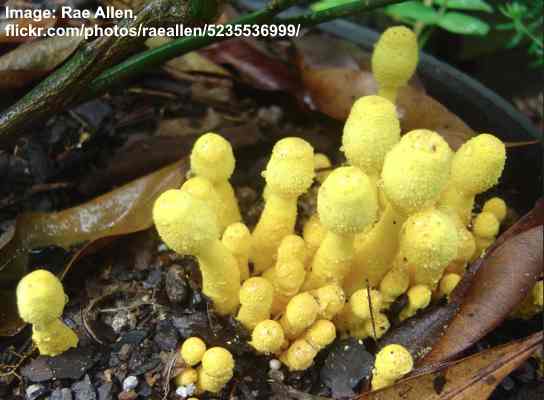
A cluster of Leucocoprinus birnbaumii mushrooms in a pot
Yellow mushrooms (Leucocoprinus birnbaumii) growing in houseplant soil are easy to identify due to their bright yellow color, conical or egg-shaped scaly caps, and vibrant yellow inner flesh. These yellow mushrooms are typically the only ones you’ll find in your houseplant soil. Under the rounded caps are closely spaced sulfur-yellow gills that do not attach to the stems.
Yellow houseplant mushrooms have a bulbous bell-shaped lemon-yellow cap that tends to flatten with age. The caps can grow 0.78” to 3” (2 – 7.5 cm) wide and sit on stems 1” to 3.5” (2.5 – 9 cm) tall. In time, the brightly-colored lemon gills may darken to a brown color.
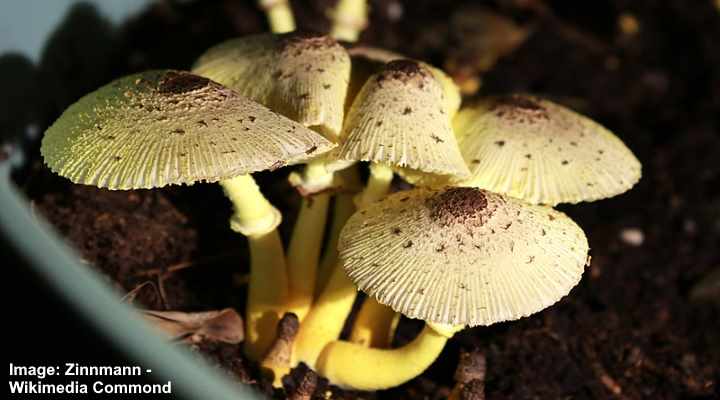
Two day old Leucocoprinus birnbaumii mushrooms in a flower pot where they develop flat caps
Another way to identify these yellow mushrooms is to test the soil. Yellow flowerpot parasols typically only grow in wet, soggy soil. Therefore, if it is summertime and the potting soil is saturated, the yellow mushrooms will typically be the species of fungus called Leucocoprinus birnbaumii.
Does the Yellow Houseplant Mushroom Harm Indoor Plants?
Yellow mushrooms growing in potted plants are not a cause for concern. Mushrooms typically grow in rich, fertile soil, so the appearance of yellow mushrooms indicates good soil conditions. However, these yellow mushrooms thrive in damp, soggy soil, which is not ideal for most houseplants.
Since overwatering is a common cause of yellow mushrooms, it’s important to consider the health of your potted plants. Many houseplants can become weak and susceptible to disease when grown in excessively wet soil. Classic signs of root rot include yellowing leaves, wilting stems, black spots on leaves, and stunted growth.
Why Do Yellow Mushrooms Grow in Houseplants?
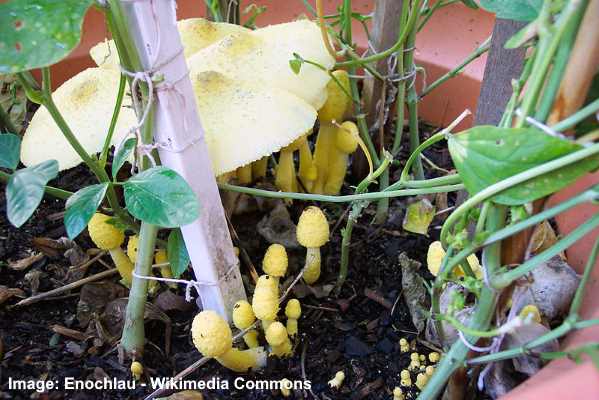
Leucocoprinus birnbaumii mushrooms growing in potting soil
Yellow houseplant mushrooms grow in potting soil when conditions are ideal for fruiting. First, there must be spores in the soil or the plant for the yellow growths to sprout. Second, conditions for mushrooms to grow must be ideal — wet soil and warm temperatures produce an abundance of mushrooms. Third, the yellow fungi need organically-rich soil to fruit.
Therefore, it’s not uncommon for a yellow mushroom cluster to start growing at any time of year. However, they tend to grow more prolifically during the summer months.
Yellowish mushrooms seem to appear suddenly because of the length of time the mycelium takes to grow. These are the network-like fungus roots that attach themselves to plant roots. As soon as temperatures and soil moisture content rise, the fungus roots begin to fruit and grow, producing yellow growth visible above the soil.
Where Do Yellow Mushrooms Come From?
Yellow mushrooms in houseplants typically appear because the fungus spores or roots are already in the soil. These microscopic spores can lay dormant for many months or years until conditions are ideal for fruiting. Even in soilless potting mixes, the spores are difficult to eradicate.
Seeing clusters of bright yellow mushrooms for the first time will cause you to wonder where they came from. Sometimes, the yellow fungi can appear without warning, even though you haven’t changed the growing conditions. However, the good news is that yellow mushrooms can benefit the soil without harming plants.
Related: Common yellow mushrooms that you are likely to find outdoors.
Do Yellow Mushrooms Benefit Houseplants?
Yellow mushrooms have a beneficial role in the soil ecosystem. They improve the soil quality by breaking down decaying organic matter, increasing aeration, and helping plants absorb essential nutrients. In addition, some houseplant owners enjoy seeing wild mushrooms in plant pots.
One of the benefits of mushrooms to potting soil is that they increase beneficial nutrients. As the fungus roots work, they increase phosphate and nitrogen levels and lower pH levels. These elements combine to create a healthy growing environment.
Are Yellow Mushrooms Harmful to Potted Plants?
Yellow mushrooms are harmless to houseplants and plants growing outdoors in your yard. Because they improve the soil quality, there is no risk of them causing damage to plants. In addition, they are not a parasitic type of fungi; therefore, they don’t suck nutrients from the plants. In fact, they exchange nutrients with plants.
It’s good to remember that, although a type of fungus, yellow mushrooms are not the same as mold growths or fungal diseases. Therefore, confusing yellow mushrooms with dangerous mold growth would be a mistake.
However, seeing yellow mushrooms in potting soil could signify that your plant’s health is at risk. Of course, not from the fungal growths but from the growing conditions that allow yellow fungi to grow. Therefore, it may be time to change the growing conditions if you see yellow mushrooms in your potted plants.
Most houseplants — including tropical houseplants — require a loose potting soil mix that drains well. Ideally, the plant roots should always be slightly moist, but the top layer of soil must dry out between waterings.
Yellow mushrooms could signal that any of the potentially damaging conditions:
- You are overwatering the plant or watering it too often.
- Soil drainage is not adequate.
- The plant has become root-bound, causing excessive soil moisture.
Watering less frequently or repotting the plant with an aerated potting mix can help prevent yellow mushroom growth. However, yellow mushrooms can safely grow in plant pots without damaging plants, people, or pets.
The Causes of Yellow Mushrooms
The reasons for yellow mushrooms growing in houseplants are always because fungus spores are present in the soil. However, the spores can blow in from outside or get transported indoors on plants. Then humidity, warm temperatures, and overwatering cause the yellow mushrooms to start fruiting.
Therefore, bright yellow growths can suddenly appear in summer or at other times of the year. All they need to start growing is for the conditions to become ideal.
Here are six reasons for having clusters of small yellow mushrooms:
1. Yellow mushroom spores already in potting soil or on the plant
The most common reason yellow mushrooms grow indoors is that the spores are already contaminating the soil. Commercial potting soil mixes contain a mixture of beneficial microbes and nutrients to improve plant health. Therefore, it’s not uncommon for the soil to contain Leucocoprinus birnbaumii spores.
2. Yellow mushrooms can grow because the houseplant soil has poor drainage
Potting soil that drains poorly is a reason why yellow mushrooms seem to appear from nowhere. Of course, the spores must already be in the soil before they start fruiting. But compacted soil, rootbound plants, or a lack of amendments can mean that the soil starts retaining excess moisture.
3. Overwatering houseplants can cause yellow mushrooms to grow
Giving houseplants too much water or watering too often causes colorful yellow mushrooms to appear. These yellow growths often appear in summer when you don’t allow the top layer of soil to dry between waterings. The warmth and moisture activate mycelium in the soil, and yellow mushrooms appear overnight.
Of course, yellow mushrooms are harmless to houseplants. So why should you be worried? Too much moisture in the soil can cause root decay, killing your plant. In addition, the mushy roots prevent plants from absorbing nutrients. This results in potted plants with stunted growth, yellowing leaves, and wilting stems.
Therefore, if you notice yellow mushrooms, you should check your watering technique and the soil for signs of overwatering.
4. Yellow mushrooms are growing because the potting soil is rich and fertile
Yellow mushrooms in houseplants are a sign that the soil is healthy. Most varieties of mushrooms require plenty of organic matter to thrive. The mushrooms help break down this decaying material, releasing vital nutrients into the soil. Therefore, some houseplant owners leave yellow mushrooms in pots to help improve soil health.
5. Yellow mushroom spores blow in from outside
It is not uncommon for microscopic spores to blow in through open windows and land on plants and leaf surfaces. For example, yellow mushrooms in houseplants in Texas can occur because the spores can live a long time in warm outdoor temperatures. However, this type of “spore spread” can happen in most warm climates.
6. Using garden soil for houseplants can cause yellow mushrooms to grow
It’s not advisable to use garden soil for houseplants for several reasons. For example, soil from the garden is rich with fungal spores, as well as friendly and harmful microbes. Therefore, you could transmit various plant diseases to your houseplants if you pot plants indoors with soil from flower beds.
Related reading: How to make a homemade potting mix.
How to Get Rid of Yellow Mushrooms in Houseplants
The most straightforward method to eliminate yellow mushrooms from your houseplants is to handpick them as soon as they appear, thus preventing the release of spores. However, this approach may not entirely eradicate them. For a complete solution, you should consider repotting the plant with fresh soil, adjusting your watering technique, and maintaining moderate temperature and humidity levels. These measures can effectively hinder the growth of yellow mushrooms.
Let’s look in detail at how to get rid of yellow mushrooms from your houseplants.
Get Rid Of yellow Mushroom from Houseplants By Handpicking Them
The simplest method to eradicate a yellow mushroom infestation in houseplants is to manually remove them from the roots. To achieve this, use a small trowel to dig a few inches around the base of the cluster of yellow mushrooms. Then, place the undesired fungal growth in a bag, seal it to prevent spore dispersal, and dispose of it in the garbage.
Alternatively, you could put the yellow mushrooms on the compost heap. They may take root there and help the compost to decompose.
Change the Top Layer of Soil to Prevent Yellow Mushrooms in Potted Houseplants
Another way to get rid of yellow mushrooms in potted plants is to replace the top layer of soil. This can help to remove most of the mushroom roots and prevent further growth.
To replace the soil layer, remove 2” (5 cm) of soil and replace it with fresh, uncontaminated soil.
It’s good to note that this method doesn’t guarantee 100 percent results. The microscopic spores are difficult to eradicate and often remain in the root system. However, if you water your plant correctly, you can minimize the risk of the mushrooms returning.
Repot the Houseplant to Eliminate Yellow Mushrooms
Repotting houseplants that have yellow mushrooms growing can help to eliminate unwanted yellow visitors. In any case, repotting your plants is a good idea to replenish soil nutrients, and putting rootbound plants into larger pots encourages healthy growth.
To repot houseplants, remove the root ball from the pot and dispose of any signs of yellow mushrooms. Additionally, check the roots for a whitish cotton wool-like substance. Try to remove these fungus roots if possible. Next, half-fill a pot with fresh soil, put the plant in, and fill to the top with a fresh potting mix.
It is also a good idea to amend potting soil with perlite. This natural substance improves poor soil aeration and improves drainage.
Prevent Yellow Mushrooms from Growing in Houseplants by Changing Your Watering Schedule
You can prevent the growth of yellow mushrooms in houseplant soil by adjusting your watering technique. Yellow mushrooms require specific conditions to flourish, often thriving in excessively moist soil. Consequently, it’s advisable to water houseplants only when the top 2 inches (5 cm) of soil has fully dried.
When watering houseplants, it is better to water them less frequently and saturate the soil rather than watering frequently and only a little. Always remember to allow excess water to drip from the drainage holes and never allow houseplants to stand in a saucer of water for an extended period.
Even if yellow mushroom spores are in the soil, a lack of adequate moisture prevents them from fruiting. As a result, you will probably never see yellow mushrooms again.
How to Prevent Yellow Mushrooms
The best way to stop yellow mushrooms from returning is by correctly watering your plants. The fruiting bodies have trouble growing in dry soil. Therefore, keep soil on the drier side rather than wetter to ensure healthy soil and plants. This way, you should avoid seeing bright yellow growths in potting soil
You can also put a layer of fine gravel mulch over the soil surface. This can prevent fungus growths from taking hold.
Suppose small yellow growths start to appear. In that case, remove them before their caps open and they release spores.
Are Yellow Mushrooms Harmful to People?

Don’t ingest Leucocoprinus birnbaumii mushrooms as they are poisonous to humans and pets
Yellow mushrooms are harmless to humans unless you ingest them. They are safe to handle, and unlike mold growths, their microscopic spores are not harmful. Therefore, you can simply remove them with your hands if you don’t want them to grow in your houseplants.
However, it’s good to note that yellow mushrooms Leucocoprinus birnbaumii are considered poisonous mushrooms. Therefore, you should not consume them. Researchers at Michigan State University say these yellow mushrooms can be toxic in large amounts. So despite its cute appearance, the colorful mushroom isn’t among the list of edible mushrooms safe to eat.
Reports suggest that eating yellow mushrooms cannot kill you. However, ingesting the bright fungi can cause gastrointestinal upset, including nausea, cramping, diarrhea, and vomiting.
Do Yellow Mushrooms Harm Pets?
One reason to remove yellow mushrooms from potted houseplants is that they can be harmful to animals. Cats and dogs that consume Leucocoprinus birnbaumii may also suffer from digestive issues like vomiting, gastrointestinal pain, and diarrhea.
Discover many other types of yellow mushrooms that you are likely to find outdoors.
Related articles:
